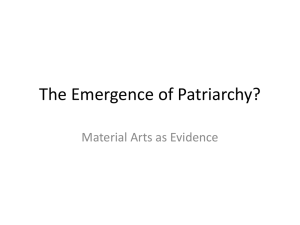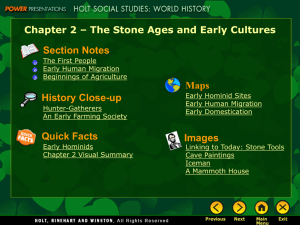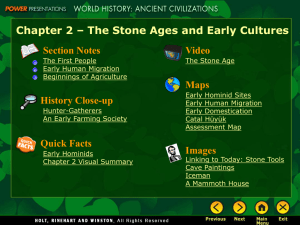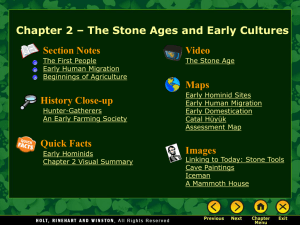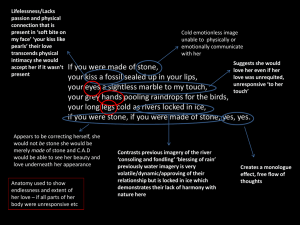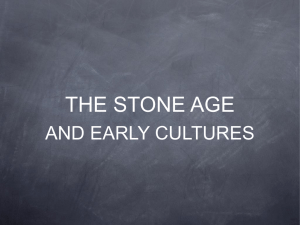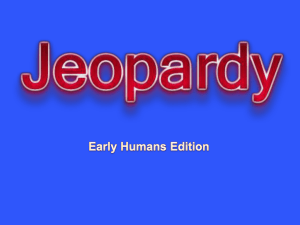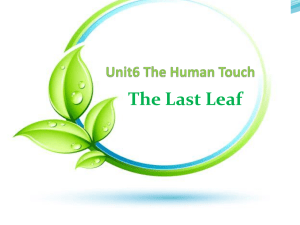Chapter 1- The Beginnings of Human Society
advertisement
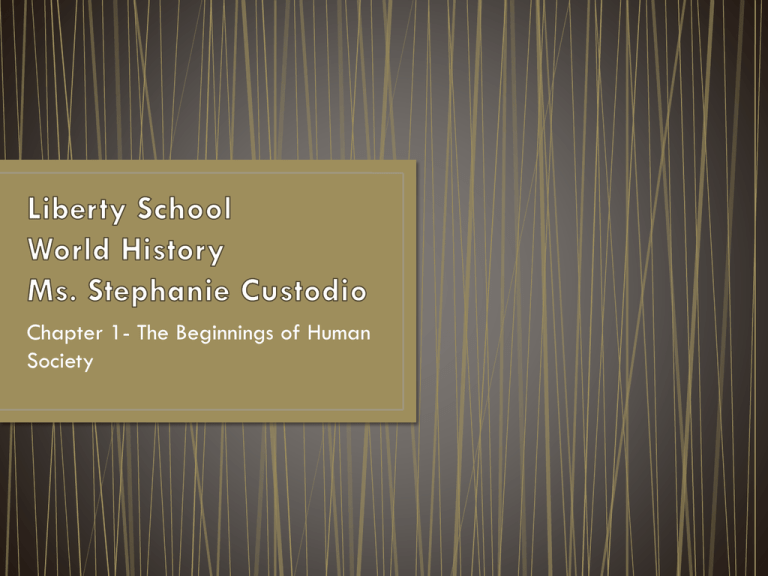
Chapter 1- The Beginnings of Human Society Section 1 • He is called the Iceman. His frozen body was found in a mountain pass in the Alps, on the Italian-Austrian border in Europe by two hikers in 1991. • His clothing, tools, and his body were well preserved. They provided clues that helped build a story of his life. • Scientists determined that the Iceman lived about 5,000 years ago, about 3,000B.C. • Prehistory: the time before writing. • History: the written and other recorded events of people. • People in Southwest Asia and in Africa developed a system of writing about 5,000 years ago. This development marked the beginning of history. • Archaeologist: Scientist who examines objects to learn about the human past. • Scientists must rely on clues other than written records to learn about life in prehistoric times. They look for: • Bones • Tools • Other objects • Historians also study the written records of human life and accomplishments to understand a society – its wars, religion, and its rulers, among other things. • They also look at what other groups living at the same time wrote about that society. • Oral traditions: stories passed down by word of mouth. • Oral traditions can include a family’s history (stories of grandparents, parents and greatgrandparents), or stories about heroes or events in the past. • Not all stories are accurate and they often contain acts mixed with personal beliefs and exaggerations about heroes. • Geography: the study of Earth’s surface and the processes that shape it. • It also refers to the features of a place: its climate, landscape, and location. • Knowing the connections between geography and history is often the key to understanding why events happened: • Weather patterns, the water supply, the landscpae of the place, they all affect people that live in a place. • Example: Egyptian cilization built on the banks of the Nile River. Comprehension and Critical Thinking 1. What do scientists study to learn about prehistory? 2. What do we know about societies that leave behind written records? 3. Analyze the clothes you wear and the things you carry to school. What do they say about your life? How does your story comprare to the Iceman’s story? 4. Name some examples of familiar geographic features. 5. How can geography help us to understand history? 6. What effect has geography had on the way people in your community live? Section 2 • About three and a half million years ago, a huge explosion shook a part of East Africa. A volcano spit out clouds of fine ash that fell on a surrounding land. Then rain came. It turned the blanket of ash into thick mud. Before the mud dried, two individuals walked across the landscape. As they walked, they left their footprints in the mud. • In 1976, a group of scientists discovered the footprints preserved in stone. They were amazed at their find. The footprints are almost identical to those made by modern humans walking in wet sand. • Hominids: a term that refers both to modern humans and to earlier groups that may have included ancestors or relatives of modern humans. • Stone Age: period during which hominids, including modern humans, made lasting tools mainly from stone. • They also made tools from wood and animal bones. • Scientists believe the Stone Age continued for hundreds of thousands of years, until people learned to use metals for tools. • Archaeologists divide the Stone Age into three periods: • The Old Stone Age- modern humans and other hominids did not yet know how to farm • The Middle Stone Age- characterized by the use of more refined or advanced tools • The New Stone Age- when people began the practice of farming • Hominids learned how to use fire between about 1,400,000 and 500,000 years ago. • Nobody knows for sure how they learned. • Theory #1: one day a band of hunters saw a grass fire caused by a lightning and they learned how to keep it going. • Theory #2: by rubbing two sticks together to produce a spark • Theory #3: by striking stones together to produce a spark • With fire, people could ward off dangerous animals, who were afraid of fire. • With the ability to create fire, our ancestors could move to areas with a colder climate. • As early hominids developed the use of tools, they left their original homes in Africa, about one million years ago. • Many early hominids were nomads: people who have no settled home. • They moved to find food, and when they gathered all the food around them, they moved. • Evidence shows: • Early hominids were living in Asia and Europe at least 500,000 years ago. • Modern humans originated more than 100,000 years ago in Africa and then spread to other parts of the world. • 30,000 years ago humans crossed from Asia to North America. • By 10,000 B.C. humans had reached Chile in South America. • People in southwest Asia discovered, about 11,000 years ago, that if they planted the seeds of wild grasses, new crops of grasses would come up. • This began the New Stone Age in Southwest Asia. • People began to grow their own food, but still depended on stone tools. • At the same time that people began to grow their own food, some people became pastoral nomads- they raised livestock and traveled from place to place in search of grazing areas for their animals. • Women were responsible for gathering plants and seeds . Men were usually hunters. • Some places were better for farming than others: • Soil was more fertile • Areas had long springs and summers • Gentle rains • 9,000 years ago, Chinese farmers began to grow rice and other crops. • A little later in Central America, people began to grow corn, beans, and squash. • When people first began to plant crops, they carefully chose seeds from the biggest, best-tasting plants, they began to domesticate them. • Domesticate: to adapt wild plants or tame wild animals and to breed them for human use. • Very gradually, this selection of seeds and roots from each crop led to the kinds of food that we eat today. • Humans learned to tame wild animals and breed them for human use during the New Stone Age. • The first domesticated animals may have been dogs, because they’re valuable in hunting. • People also tamed sheep, goats, and pigs for sources of meat, milk, wool and skins. • By about 2500 B.C., cattle, camels, horses and donkeys were trained to carry heavy loads. • Since ancient times, many animals have been captured in the wild and tamed: • People of Ancient India tamed wild elephants to use in battle. • Ancient Assyrians and Egyptians trained wild cheetahs for hunting. • Humans have tried and failed to domesticate many species over the course of history. Comprehension and Critical Thinking 1. Describe how hominids of the Old Stone Age survived. 2. What important skills did hominids of the Old Stone Age use to find food? 3. How did survival skills change as people began to settle? 4. What marked the beginning of the New Stone Age? 5. How was life in the New Stone Age different from the life in the Old Stone Age? 6. What are the effects of geography and climate on farming? Section 3 • Under a fierce desert sun, long lines of people are digging a trench that will soon become a deep canal. Other people lift heavy baskets of dirt dug from the canal onto their shoulders. They dump the dirt near the river where another crew is building a huge earthen dam. • These are some of the world’s first construction workers. They are building a system of irrigation. • Irrigation: supplying land with water through a network of canals. • One person directs the work at each site. • Soon, the dam will hold back the spring floodwaters of the river. A group of people are building wooden gates in the dam. Officials will open the gates in the dry season, allowing water to flow through the canals and irrigate the growing crops. • Farming techniques, like this irrigation system were important in creating early communities. • Although farming was much harder work than hunting and gathering, people could have a steady supply of food year-round. • People did not have to travel from place to place. • People often had a food surplus, which could be stored for use at another time. • Surplus- more than what is needed. • The hunting-gathering life did not allow parents to have many children. Now, food surpluses would feed many more people. • Larger families brought rapid population growth. • About 10,000 years ago, the population of the world was about 5 million people. • By 7,000 years ago, many people had settled into the farming life. The world’s population then, was as much as 20 million. • People lived in New Stone Age farming settlements for many centuries. As population increased, the settlements grew into towns. • With food surpluses, people did not have to spend all day producing food, so they switched to other kinds of work. • Some people became artisans: a worker who is especially skilled at crafting items by hand. For example: baskets, leather goods, tools, pottery, or cloth. • Cities were more likely to develop in areas where rich soil created large surpluses of food. • People also needed a dependable source of drinking water and materials to build shelters. • Some of the earliest cities grew up along large rivers, for example: • • • • The Nile in Egypt Tigris and Euphrates in Iraq The Huang in China The Indus in Pakistan • Differences between early cities and farming villages: • Cities were larger. • Cities had large public buildings: to store surplus grain, for the worship of gods, to buy and sell goods. • In villages most people were farmers. In cities, workers had a great variety of occupations. • Governments formed as the population of cities grew. • They were in charge of: • • • • Keeping order in society Provide services Settle disputes Managed public building and irrigation projects. • Over time, some New Stone Age societies grew into civilizations. • Civilization: a society that has cities, a central government run by official leaders, and workers who specialize in various jobs. • Writing, art, and architecture also characterize a civilization. • By 6,600 B.C., artisans in Europe and Asia discovered that melting a certain rock at high temperatures would separate the metal copper from the rock. • By 3,300 B.C., artisans had learned to mix copper with tin to make a mixture called bronze. • This discovery (maybe accidental) marked the beginning of the Bronze Age. • Bronze is much harder than copper, so it could make items more durable: weapons, tools, helmets, shields, etc. • Traders took valuable items such as pottery, tools, and weapons, baskets, cloth, and spices to faraway cities. They traded this items for food and goods that people at home wanted. • By around 3,500 B.C., people had invented the wheel and axle. • With it, trade loads could be loaded into carts and pushed through the city to market. • More goods could be transported farther and more easily. • Trade over water also developed. • Merchant ships carried goods across seas and rivers. • With all this travel, people of many different cultures came into contact with one another. New tools and ideas from one society soon spread to other societies. • Growing trade links brought prosperity to the cities, and prosperity led to the development of social classes. • Social Class- group of people having similar backgrounds, incomes, and ways of living. • The king was the most important and powerful person. • Priests of the city’s religion were the second in importance, along with nobles, who were government officials and military officers. • Below were artisans, small traders, and merchants. • Common workers and farmers were the lowest ranked free members of society. • Slaves formed a separate social class. Most of them worked in cities as household servants and as laborers. They were owned as property by other people and were not free. 1. 2. 3. 4. 5. Comprehension and Critical Thinking 6. 7. How did people’s lives change when they began to produce their own food? What effects did food surpluses have on people and populations? What resources were necessary for villages to grow into cities? What were the similarities and differences between villages and cities? What developments occurred as societies grew into civilizations? How did properity lead to the development of social classes? Suppose you’re an early trader bringing tools and weapons made of bronze to people who have never seen bronze before. Write a speech in which you try to persuade these people to trade for your bronze goods.

